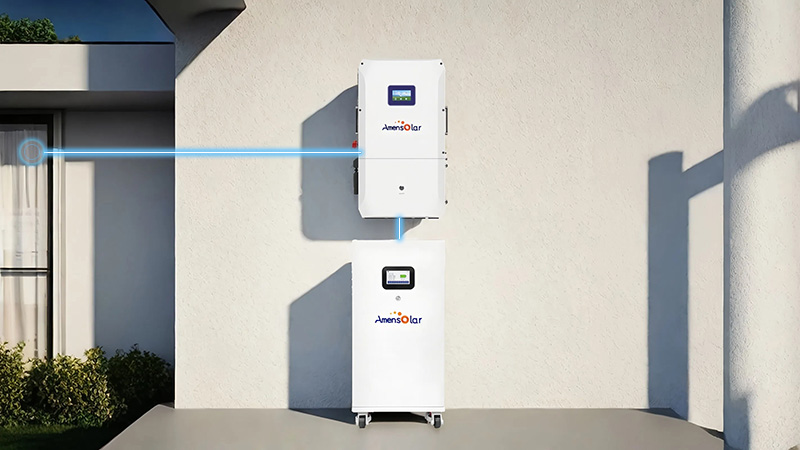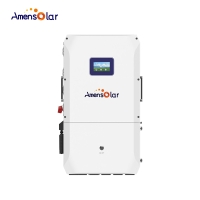Troubleshooting Guide for Energy Storage Inverters – How to Solve the Most Common Issues
As renewable energy adoption accelerates, energy-storage inverters have become indispensable for homes and businesses. When a fault occurs, however, normal power supply can be interrupted. This article uses Amensolar’s storage inverter as an example, providing step-by-step guidance to identify and resolve the most frequent problems so your system stays efficient and reliable.
1. Battery Will Not Charge or Discharge
• Check all battery cables for looseness, corrosion or physical damage.
• Measure battery voltage and confirm it sits within the inverter’s accepted range (too high or too low triggers automatic protection shut-down).
• Verify that the Battery Management System (BMS) is communicating correctly; a failed BMS will block both charge and discharge.
2. Inverter Powers On but Remains Unresponsive
• Confirm that AC input (grid or generator) and DC input (battery/PV) are both present and correctly wired.
• Inspect every breaker, fuse and connector for open circuits or shorts.
• If inputs are normal, perform a full restart: switch the unit off, wait 60 s, then switch back on.
• Check whether any protection mode—over-temperature, anti-islanding, etc.—has been triggered; clear the underlying cause before restarting.
3. Abnormal Output Voltage
• Ensure incoming grid or battery voltage is stable.
• Review the inverter’s operating mode settings (on-grid, off-grid, UPS, etc.) and correct if necessary.
• Verify that the total load does not exceed the inverter’s rated power; overload can distort the output waveform.
• If the problem persists, contact a certified technician for internal circuit inspection.

4. Excessive Noise During Operation
• Inspect the cooling fan: remove any debris caught in the blades and confirm it spins freely.
• Make sure the unit is installed with at least the manufacturer-recommended clearance on all sides; cramped spaces amplify fan noise.
• Clean dust from air vents every 3–6 months; clogged vents force fans to run faster and louder.
• If noise remains unusually high, electromagnetic interference or a failing inductor may be the cause—seek professional support.
5. Over-Temperature Shutdown
• Verify that intake and exhaust vents are unobstructed.
• Reduce ambient temperature by improving ventilation or relocating the inverter away from heat sources.
• Check load levels; sustained overload raises internal temperatures quickly.
• After clearing the cause, allow the unit to cool and then restart. Amensolar inverters automatically resume operation once temperature returns to safe limits.
6. Blank or Error-Ridden Display
• Ensure the display’s ribbon cable and power leads are firmly seated.
• Power-cycle the inverter; a simple reboot often clears temporary firmware glitches.
• Note any fault codes shown on-screen and consult the user manual for specific remedies.
• If the screen remains blank or continues to show unrecoverable errors, contact Amensolar technical support.
7. Communication Failures
• Inspect all RS-485, CAN or Ethernet cables for breaks or loose connections.
• Match communication parameters—baud rate, protocol, device address—across every component in the system.
• Ensure every device shares a common, low-impedance earth ground; poor grounding is a leading cause of data errors.
8. Inability to Feed Power to the Grid
• Measure grid voltage and frequency; values outside the inverter’s programmed limits will block export.
• Review anti-islanding and grid-code settings; parameters must match local utility requirements.
• If the grid is stable and settings are correct yet export is still disabled, internal relay or sensing circuitry may have failed—arrange a service call.
Conclusion
Storage inverters are robust, but periodic faults are inevitable. By following the systematic checks above, most issues can be diagnosed and resolved quickly without downtime. Amensolar’s built-in protections safeguard both equipment and users; knowing how these safeguards operate—and when to involve qualified technicians—will extend service life and maximize energy efficiency.
For further assistance, consult your user manual or reach out to Amensolar’s technical support team.

 N3H-X16US 16KW | Split Phase |...
N3H-X16US 16KW | Split Phase |...  N3H-X12US 12KW | Split Phase |...
N3H-X12US 12KW | Split Phase |...  N3H-X10US 10KW | Split Phase |...
N3H-X10US 10KW | Split Phase |...  N3H-X8US 8KW | Split Phase | ...
N3H-X8US 8KW | Split Phase | ...  N3H-X5US 5KW | Split Phase | ...
N3H-X5US 5KW | Split Phase | ...  N1F-A3US 3KW | Split Phase | ...
N1F-A3US 3KW | Split Phase | ...  N1F-A12US 12KW | Split Phase |...
N1F-A12US 12KW | Split Phase |...  N1F-A6.5US 6.5KW | Split Phase ...
N1F-A6.5US 6.5KW | Split Phase ...  N1F-A6.2P 6.2KW | Single Phase...
N1F-A6.2P 6.2KW | Single Phase...  N1F-A6.2E 6.2KW | Single Phase...
N1F-A6.2E 6.2KW | Single Phase...  AMF16000 51.2V | 16KWH | Floo...
AMF16000 51.2V | 16KWH | Floo...  AMW10240 51.2V | 10.24KWH | W...
AMW10240 51.2V | 10.24KWH | W...  LFP 16kWh / LV 51.2V | 16KWH | Floo...
LFP 16kWh / LV 51.2V | 16KWH | Floo...  S52300 51.2V | 16KWH | Stac...
S52300 51.2V | 16KWH | Stac...  S52200 51.2V | 10.24KWH | S...
S52200 51.2V | 10.24KWH | S...  AML12-200 12.8V Series LifePo4...
AML12-200 12.8V Series LifePo4...  AML12-100 12.8V Series LifePo4...
AML12-100 12.8V Series LifePo4...  AML12-120 12.8V Series LifePo4...
AML12-120 12.8V Series LifePo4...  AML12-150 12.8V Series LifePo4...
AML12-150 12.8V Series LifePo4... 